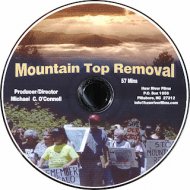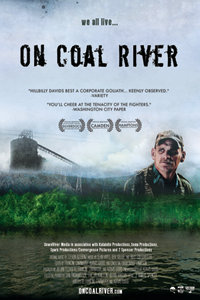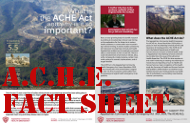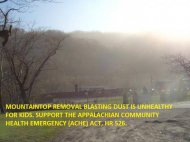
Report from Citizens' Inspection of Coal River Mountain
Aug 2, 2011
On July 26, in conjunction with Coal River Mountain Watch's protest of the renewal of the 1,095 acre Bee Tree strip mining permit on Coal River Mountain, we performed a citizens’ inspection of the Bee Tree site, owned by Marfork Coal Company, a subsidiary of Alpha Natural Resources. Allies Ernie Thompson of Horse Creek, WV, Paul Corbit Brown of Pax, WV and I [Rob Goodwin] were accompanied by DEP Permit Supervisor Tom Wood, and two engineers employed by Marfork, Mark King and Barry Hudson.
The visit began with a brief safety training at Marfork Coal Company headquarters, just past the security gate in Little Marsh Fork holler. The late Judy Bonds and her brother Ernie Thompson grew up playing in the creek only a couple hundred feet from this location. Unfortunately, this area has been gated off with strict security for several years now, denying local residents access to the holler and much of Coal River Mountain.
We traveled up onto the active portion of the strip mine to assess what land Marfork had mined recently, what land Marfork was mining presently, and to gauge how quickly and where Marfork is going to progress with its next destruction. Marfork’s permit plans to use 200 of its 1,095 acres for non-mining purposes such as construction and roads. From this portion of the land, the company can only collect ‘incidental coal,’ or coal that is acquired as a result of constructing roads. Marfork currently plans to mine 200 acres, and has begun strip mining on a little more than 75 acres of this portion of the permit. The EPA has stalled valley fill permits for the Bee Tree site, but Marfork is getting around this obstacle by strip mining without filling valleys. It is likely that Marfork will submit plans to mine a significantly larger portion of the 800 proposed acres. Mark King repeatedly said that how far the company goes all depends on the market for coal. He guaranteed us that he would get another five productive years out of this permit as it stands.

Photo Credit: Paul Corbit Brown
Marfork has already been issued several violations by the DEP. We moved on to inspect the area where two violations were issued in March of 2011. One violation was for material that had ventured down the slope off the permit area. The company also received a violation for failing to establish proper sediment control at the top of the slope, likely resulting in the landslide. The abatement requirements were very standard of the WV DEP enforcement; the company received a small fine of $3,000 and the DEP told them to remove the material from the non-permitted area and place it in a stable location. They were also required to revise their permit to include that area that had been disturbed. Although they have mostly cleaned up the material, they have not done so to a satisfactory degree, and they have yet to submit the revision to include the additional area of the permit.
We examined a third violation at the part of the mine apportioned for non-mining purposes. The company has created a deep cut in the mountain for a road called IBR 2. Cutting this road provided an excuse to extract the “incidental coal.” About a year ago, they were issued a violation for augering into the sides of the mountain in this area with the highwall miner, a form of mining growing in popularity with increased scrutiny of valley fill permits by the EPA.
Despite a specific and clear provision in the permit disallowing highwall mining in this area, the company went ahead and used the machine. Coal River Mountain Watch had warned the DEP of this potential problem just weeks before it happened and the DEP failed to prevent the company from willfully violating the law. Although the wall is now covered up, we were told that there were about 6 holes drilled into the side of the mountain. The company received a $774 fine for this violation. Marfork made a lot more money off the coal recovered than that violation cost them, and they likely would have made a lot more if CRMW had not raised concerns because who knows how far they would have gone unchecked.
It seemed as if the company wanted to give the impression of being environmentally conscious, which fits well with the intensive green washing campaign Alpha has launched to rid of their scarred Massey image. When we examined a valley fill that is being constructed at the head of the Brushy Fork Impoundment, engineer Mark King explained the benefits of the upstream valley fill construction method, in which reclamation of a valley fill is preformed during construction as opposed to after the fact. DEP Supervisor Tom Wood added that this type of construction is better for water quality. In this case, water quality is not particularly an issue because discharges from the bottom of the fill flow into the Brushy Fork impoundment, a pond filled with seven billion gallons of toxic coal slurry.
I still believe that Alpha is incapable of reclaiming land in a way that comes even remotely close the way it existed for thousands of years. Chief Engineer, Barry Hudson agreed with me that compaction of the top four feet of soil should be minimal because it allows for better development of a root base to re-vegetate the area quicker. It’s great that Mr. Hudson understood the myths about compaction, but minimal compaction is only worthwhile if you are planting trees. Marfork would like to save money by not compacting the soil and planting grass but the company is still not willing to pursue the costly option of planting trees. Furthermore, the soil composition is far from appropriate for adequate growth. Mr. Hudson is under the wrong impression that before long, the rocky material thrown into the reclamation site will become weathered sandstone and be just as good as the original soil.
Before the hearing for the renewal of the Beetree permit on August 9th, we are going to file a request to return to the site and inspect the seismographs, piezometers, blasting logs, and seven-day impoundment inspection reports to verify Marfork’s data on the effect of Bee Tree blasting on the Brushy Fork impoundment.
After analysis of the water quality data of Beetree Branch, we found quickly escalating levels of aluminum in a stream into which the Beetree mine discharges. Armed with this data, we will make our case that the Beetree permit should not be renewed.
At one point, Mr. Hudson asked me to explain the community’s concerns, who I was, and where I was from. I needed to respond strategically to the typical “you are an outsider, what are you doing here” language, so I said, "I grew up in the Adirondacks in upstate New York. You know – way up north near the Canadian border.”
"That's glacier country up there, isn’t?” Mr. Hudson replied.
“Yes,” I said. “There were glaciers that covered much of the mountainous eastern US, but Southern Appalachia is unique. Because there were no glaciers here, the topsoil is some of the oldest in the world and that's why there are ramps, ginseng and molly moochers among other valuable species. What you are doing here on this mine site is destroying the 10,000 year-old species that, regardless of what you do, will not grow back. Even if you wait 10,000 more years, there is no guarantee it will ever be like it was. People in the community are concerned because they have thrived off harvesting these species for generations and now they are being destroyed. This destruction, combined with a lack of access to the mountain due to security, blasting, and active mining is a huge concern of the community. That just may be why so many people are protesting this."
By Rob Goodwin, CRMW Citizen Enforcement Project staff member













